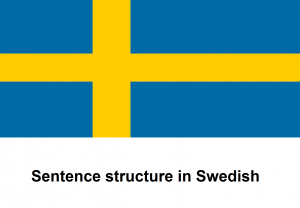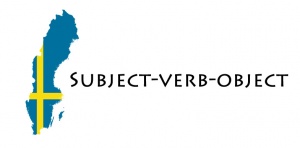Language/Swedish/Grammar/Sentense-Structure
Hej everybody,
In today's lesson you will learn how to form a sentence in Swedish.
Subject-verb-object
Each language has a particular sentence structure and they are all built up by grammatical functions:
- Subject --> the person/animal/thing doing something
- Verb --> what the person/animal/thing is doing
- Object --> who/what is being affected by what the subject is doing
Simple word order
In Swedish, the sentence structure is built with SUBJECT-VERB-OBJECT. We call it "simple word order."
Example
Jag läser en bok (I read a book)
- To know the subject, ask yourself: Who is reading? --> "Jag", so "jag" is the subject.
- To know the verb, ask yourself: What is "jag" doing? --> "Läser", so "läser" is the verb.
- To know the object, ask yourself: What is being read? --> "En bok", so "en bok" is the object.
Reversed word order
Swedish also has something called "reversed word order" which means that if something else than the subject comes first in a sentence, we have to move the verb to the second position.
Example
- Jag läser en bok
(S) (V) (O)
- I dag läser jag en bok (Today I read a book)
(V) (S) (O)
Do you see that "läser" and "jag" have switched places? A good tip is to think that the verb ALWAYS should be in the second position in a sentence.
Main sentence
A main sentence can always stand alone. The meaning of the sentence is clear without further explanation. Subject and predicate (=verb) stand together. The predicate (=Verb) always stays on the 2nd place.
A regular Swedish main sentence follows the rule SPORT:
Subject – Predicate (=Verb) – Object – Rum (=place) – Tid (=time)
Jag (S) läser (P) en bok (O) i mitt rum (R) idag (T). / I read a book in my room today.
An irregular Swedish main sentence can begin with O/R/T, so the word order changes:
- Let’s start with the object O-P-S-R-T: En bok (O) läser (P) jag (S) i mitt rum (R) idag (T)./ A book do I read in my room today.
- Let’s go on with the rum R-P-S-O-T: I mitt rum (R) läser (P) jag (S) en bok (O) idag (T). / In my room do I read a book today.
- And the tid in the beginning T-P-S-O-R. Idag (T) läser (P) jag (S) en bok (O) I mitt rum (R)./Today do I read a book in my room.
By changing the word order from SPORT to these, do you emphazise the fat marked words of the sentence.
Main sentence and adverb
An adverb is inte=not, ofta=often, alltid=always, alldrig=never, ofta=often, sällan=seldom etc.. It specifies the verb that is used in the sentence.
A regular Swedish main sentence follows the rule SPORT plus an adverb SP(a)ORT
Subject – Predicate (=Verb) – adverb - Object – Rum (=place) – Tid (=time)
- Jag (S) läser (P) inte (a) en bok (O) i mitt rum (R) idag (T). / I do not read a book in my room today.
As in English the adverb specifies the verb, so they stand in a regular SP(a)ORT-main sentence always together. But note in Swedish comes the adverb always after the Predicate (=verb).
An irregular Swedish main sentence plus an adverb
- Let’s start with the object O-P-S-(a)-R-T: En bok (O) läser (P) jag (S) inte (a) i mitt rum (R) idag (T)./ A book do I not read in my room today.
- Let’s go on with the rum R-P-S-(a)-O-T: I mitt rum (R) läser (P) jag (S) inte (a) en bok (O) idag (T). / In my room do I not read a book today.
- And the tid in the beginning T-P-S-(a)-O-R. Idag (T) läser (P) jag (S) inte (a) en bok (O) I mitt rum (R)./Today do I not read a book in my room.
The adverb in a regular SPORT-main sentence always comes after the Predicate (=verb): SP(a)ORT. The adverb specifies the verb, so they stand together.
In an irregular Swedish main sentence, beginning with O/R/T the word order changes. So is the adverb. The adverb stands now always together with the Subject, so O/R/T-P-S-(a).
But note: in all Main sentences (regular/irregular/ + adverb) stands the predicate (=verb) at the 2nd place. And subject and predicate (=verb) stand together either like this in the regular Main sentence (S-P) or in the irregular Main sentence (P-S).
Main sentence and Subclause
A subclause begins with a subjunction like därför att/för att/eftersom = because, trots att/fast/fastän = although, att=that, genom att= thus, för att = in order to, utan att= ohne dass, medan= while, sedan = afterwards, när = when, om = if etc.
The subclause specifies the Main sentence, the subclause can never stand alone, so there must be a Main sentence.
The sentence structure of the subclause never changes, if the whole sentence starts with the Main sentence or the subclause is unimportant, it stays the same. The word order in a subclause is always like this: (,)-Subjunction-Subject- Predicate (=Verb)-O/R/T.
In Swedish a komma is seldom used, but can be there as an indicator that a subclause is coming. The safest way is to identify the subjunction which must be there to introduce the subclause.
Main sentence, followed by subclause
Jag läser en bok idag, medan jag är i mitt rum. / I read a book today while I am in my room.
So, let’s identify the Main sentence, which can stand alone: Jag läser en bok idag./ I read a book today.
Followed by the subclause, which specifies the mainclause and cannot stand alone. It starts with a subjunction, here “medan= while”, sometimes there is also a komma befor it:, medan jag är i mitt rum.
Subclause first, followed by Main sentence
You can put the subclause first place. Then the word order changes in the Main sentence.
Let’s try it: Subclause 1st place: Medan jag är i mitt rum, (Main sentence) läser (2nd place) jag en bok idag.
So the wordorder in the subclause stays always the same: Subjunction-Subject- Predicate (=Verb)-O/R/T.
- But note, if the subclause is in the 1st place, the word order in the Main sentence is changed to: P (=verb)-S-O/R/T. The reason is that in Swedish the whole subclause is here seen as one and in the 1st place of the whole sentence (=Subclause + Main sentence). And the rule is the predicate (=verb) must always be in the 2nd place. So 1st place subclause, 2nd place predicate (=verb) and this is why the mainclause starts in this case with the predicate (=verb). Predicate (verb) and Subject go always together, also here.
Main sentence and Subclause + adverb
So, now, we add an adverb to the sentence.
Main sentence, followed by subclause
Jag läser en bok idag, medan jag inte är i mitt rum. / I read a book today while I am in my room.
As we have learned already, in a regular mainclause the adverb would be after the predicate (=verb) like this SP(a)O(R)T: Jag läser inte en bok idag.
But note in the subclause that the adverb comes always after the subject like this S (=subjunction)-S(ubject)-a(dverb)- predicate (=verb)-O/R/T: medan jag inte är i mitt rum.
Subclause first, followed by Main sentence
Remember: the word order of the subclause never changes, so the adverb stays again after the subject.
The same as 4a): Subclause 1st place: Medan jag inte är i mitt rum, (Main sentence) läser (2nd place) jag en bok idag.
Tips hur att lära sig best ordfjöldet på huvudsatser, adverb och bisatser / Tipps how to learn the wordorder in Main sentences, with adverbs and with subclauses:
Om ni är förvirrad nu, startar ni best med enkla vanliga SPORT-huvudsatser. / If you are confused now, start best with simpel Main sentences with ordinary SPORT-wordorder.
Försätta att öva SPORT-huvudsatser med adverbet, då med förändrat ordfjöld. / Go on to study SPORT-Main sentences with placing an adverb in it.
Efter det försätta med SPORT-huvudsatser plus bisatser. / After det go further with SPORT-Main sentences plus subclause etc.
Den lättaste är att starta huvudsatsen med subjekten (SPORT) och på första platsen före bisatsen. / It is easiest to start the mainclause with the subject (SPORT) and to place the Main sentence on the first place before the subclause.
Authors
Contributors
Vincent, Maintenance script, 18.157.105.182, 18.157.131.187 and 3.126.25.160


